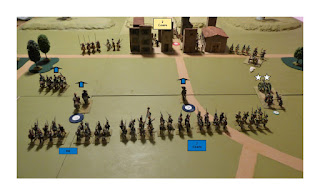12 March 1813 – Southern Spain - Day 4
Giron
orders his army to concentrate between Albareal and Toledo
He sends 1st
corps to support 3rd corps at Albareal
Suchet
orders 16th corps to move to Bargas and abandon Mocejon
This is to
protect 7th corps as they try to rally and regroup
He also
orders 15th corps to attack Albareal
This is to distract the Spanish from the weak French centre
End of Move 9
Albareal
should have been an easy French victory
It
is held by a weak 3rd Spanish corps, who have run out of supplies
They
are reduced to two infantry brigades and corps artillery
There
is also a militia brigade in garrison in the town
And
a guerrilla brigade resting in a nearby village
The
Poles are not aware that there is a full strength Spanish corps approaching
Despite
this they launch an all out attack on the weak 3rd Spanish corps
Their
cavalry charge the gunners, but are routed with 20% casualties
The
gunners then concentrate on the approaching infantry, and rout one brigade
The
Polish infantry press on and rout the two Spanish infantry brigades
At
move 9 (out of 12 moves) they spot 1st Spanish corps arriving
Without
cavalry support, and with one brigade in rout, the Poles halt
It
is clear that they could not reach the town before 1st Spanish corps
And
to do so they would have to abandon their broken infantry and cavalry
This
would allow the guerrilla brigade behind them to attack the routed troops
A
second defeat for Suchet and the whole campaign looks in danger of collapse
After
four days and four battles his army must now halt, resupply and regroup
The
Spanish army is not much better off
3rd
corps has already run out of supplies
They
will lose 400 infantry or 100 cavalry or gunners each day until they resupply
The
other three corps are down to one days supply
Each
French corps can carry a maximum of four days supplies
The
Spanish corps can only carry three days supplies
So
the Spanish need to halt and resupply more often than the French
















